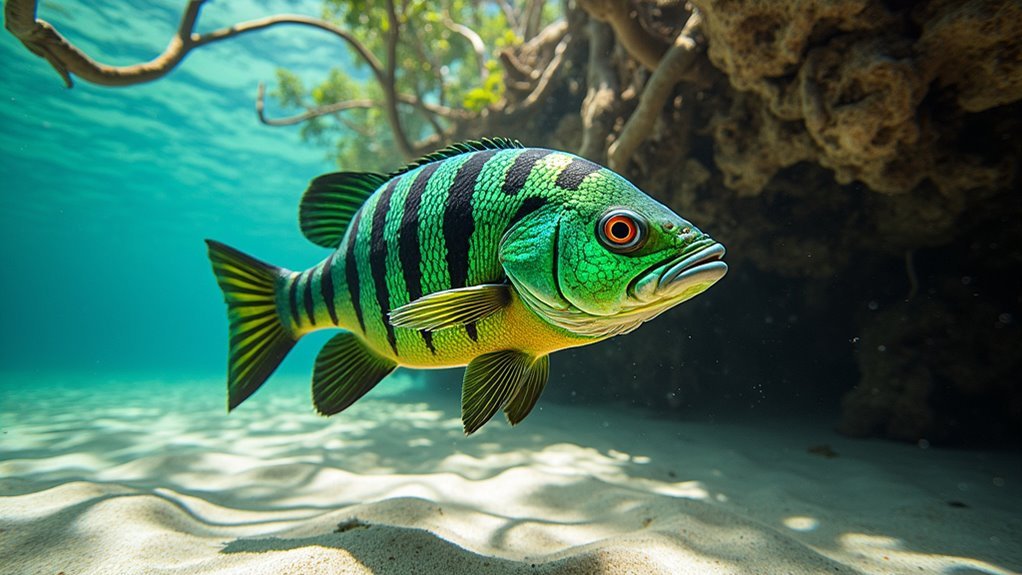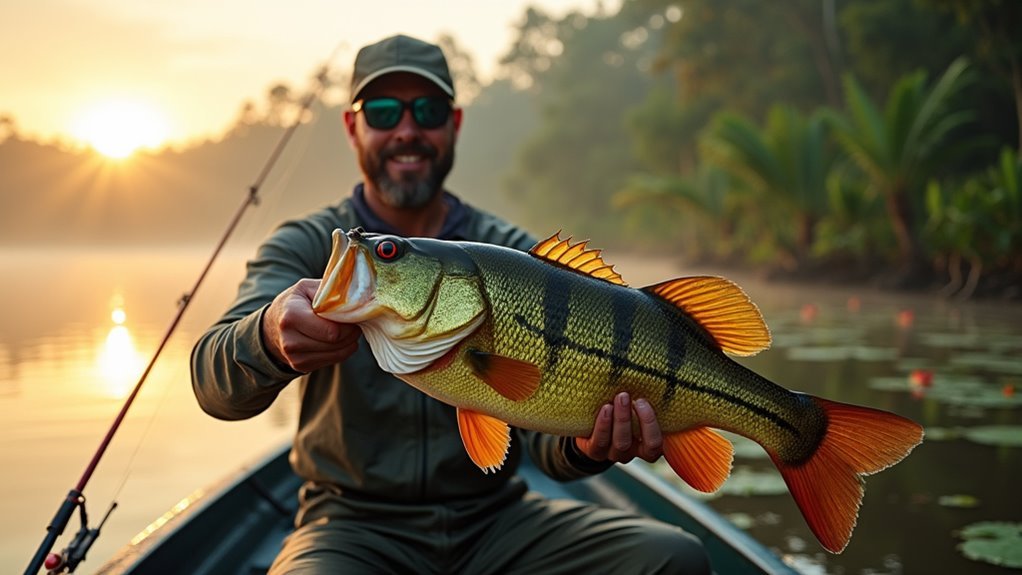We’ve found that peacock bass fishing is all about timing and technique. These colorful predators love warm waters and structured areas like canal bends and fallen trees in South Florida. They feed during daylight hours, with peak activity in late winter through spring. Live bait works wonders, but crankbaits and topwater lures can trigger explosive strikes too. Gear up with a medium-action spinning rod and polarized glasses to spot these ambush hunters. Our advanced strategies will transform your approach to landing trophy peacocks.
The Unique Nature of Peacock Bass

While many anglers mistakenly assume peacock bass are related to largemouth or smallmouth bass, they’re actually members of the cichlid family native to South America. These colorful fighters were introduced to Florida back in 1984 to help control invasive species and create exciting fishing opportunities.
What makes peacocks unique is their temperature sensitivity – they simply can’t survive in water below 65°F. We’ve seen entire populations struggle during rare cold snaps in Florida. They’re primarily found in Miami’s canal systems where the warm climate suits them perfectly. Unlike our native bass species, peacocks feed exclusively during daylight hours, making them perfect targets for day trips.
Where to Find These Vibrant Predators

Although peacock bass have spread throughout South Florida’s waterways since their introduction, finding them isn’t just about casting anywhere with warm water. These vibrant predators love structure – we’ve had our best luck targeting canal ends, bends, and areas near bridges or culverts where shade offers relief from the Florida sun.
We always look for fallen trees and dense vegetation where they ambush prey. During our last trip to Miami, we nailed three beauties hiding under a small bridge! Remember, they’re temperature sensitive and won’t feed below 65°F. A portable fish finder has saved us countless empty hours by pointing us to productive spots.
Prime Seasons and Times for Trophy Catches

Unlike some freshwater game fish that have strict seasonal windows, peacock bass offer exciting opportunities throughout the year in South Florida. We’ve found they’re most active when the sun’s shining bright, as these colorful predators are strictly daytime feeders.
| Season | Trophy Potential | Feeding Activity | Best Time |
|---|---|---|---|
| Winter (Feb-Mar) | ★★★★★ | Moderate | 10AM-3PM |
| Spring (Apr-May) | ★★★★★ | Aggressive | 8AM-5PM |
| Summer (Jun-Sep) | ★★★ | Very Active | Early Morning |
| Fall (Oct-Jan) | ★★★★ | Steady | Midday |
For those trophy catches we all dream about, late winter through spring can’t be beat. We’ve landed our biggest peacocks during these months.
Deadly Effective Lures and Baits

Now that we’ve covered when to fish, let’s talk about what to use on your line. Peacock bass are aggressive predators, and we’ve found they’ll strike at a variety of offerings. Live bait like golden shiners (peacock shiners) tends to be the most reliable method in our experience. We once caught three 5-pounders in an hour using these lively little fish in Miami’s canals.
Live bait is king for peacock bass—we’ve slayed 5-pounders all day using golden shiners in Miami’s urban waterways.
- Crankbaits and jerkbaits (2-5″) that mimic local baitfish with erratic movement
- Topwater poppers, especially during spawning when they’ll explode on surface lures
- Bucktail jigs (⅛-¼ oz) retrieved quickly to simulate injured prey
Essential Tackle and Gear Setup

The right gear makes all the difference when targeting peacock bass in Florida’s warm waters. We’ve learned through countless trips that medium-action spinning rods, around 7 feet long, paired with 2500-3000 sized reels give you the perfect balance of sensitivity and strength.
Spool your reels with 10-12lb monofilament or 20-30lb braided line. We once had a monster peacock snap 8lb test like it was sewing thread!
Don’t forget polarized sunglasses – they’re not just for looks. They’ll help you spot those colorful fighters lurking near structure, especially during those prime dawn hours.
Advanced Techniques for Landing Monster Peacocks
With the right tackle in hand, mastering advanced techniques becomes your next weapon for landing trophy-sized peacock bass. We’ve caught our share of monsters, and trust me, they fight differently than the smaller ones. When that 10-pounder hits, you’ll need more than basic skills to get it in the boat.
- Figure-eight retrieves – At the boat, convert your straight retrieve into a figure-eight pattern to trigger last-second strikes
- Teasing pauses – Stop your lure momentarily during retrieval, mimicking injured prey
- Deep water slow-rolling – Work bucktail jigs painfully slow along deep structure when peacocks are holding deep
Frequently Asked Questions
How Long Do Peacock Bass Typically Live in Florida Waterways?
In Florida’s waterways, peacock bass typically live 8-10 years. We’ve found they thrive in our warm canal systems as long as temperatures don’t drop below their 65°F tolerance threshold.
Can Peacock Bass Hybridize With Other Bass Species?
Like ships passing in the night, peacock bass can’t hybridize with largemouth or smallmouth bass. They’re cichlids, not black bass species, so we’re looking at completely different fish families despite their similar names.
What’s the Current Florida Record for Peacock Bass?
We don’t have the current Florida record for peacock bass in our knowledge base. You’ll want to check the Florida Fish and Wildlife Conservation Commission for the most up-to-date record information.
Do Peacock Bass Have Any Natural Predators in Florida?
We found that peacock bass face few natural predators in Florida. Alligators, largemouth bass, and wading birds occasionally prey on smaller peacocks, but they’ve thrived without significant biological controls since their introduction.
Are Florida Peacock Bass Populations Stable or Threatened?
Florida’s peacock bass populations are stable and thriving. They’ve successfully established themselves in South Florida’s warm waters since their 1984 introduction, with no current conservation concerns we’re aware of.
Conclusion
We’ve shown you how to dance with these colorful water warriors in their native haunts. Armed with these insights on timing, tackle, and tactics, you’re ready to experience the thrill when a peacock sends your line singing. Remember how our first Miami monster nearly spooled us last summer! With patience and practice, you’ll soon be admiring your own trophy catch, its vibrant patterns gleaming in the Florida sunshine.